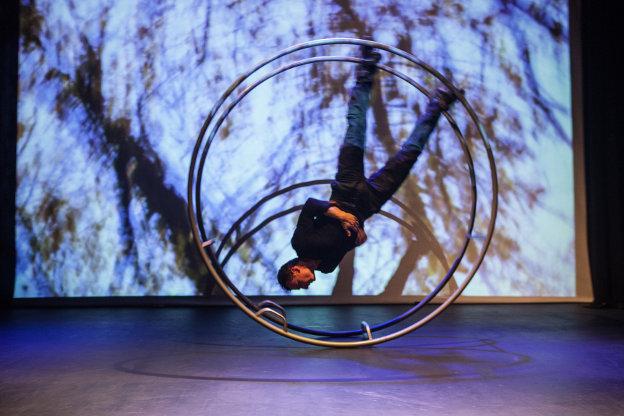Simone Riccio takes to the stage, dressed head to toe in smart-casual attire, with a peaked cap placed on his head at an enticingly jaunty angle. Then without rhyme or reason, he takes it all off to reveal another suit below. It’s a sign of things to come. He looks out at us for a while, says that he is going to tell us a story about his life and gives us a warning that he is a bit arrogant. Pride does certainly come before a fall and this piece is pretty much in free-fall descent from the off. Riccio sets up a series of moments and scenes that bear no meaningful relation to each other and that are neither interesting nor moving – however hard they are pushed.
His phone rings – it’s a friend of his; he takes the call and hangs up. It rings again, it’s his ‘Mama’ – he takes it, speaking and moving differently to the last call. It rings again – it’s a love interest, Lorena, and his stance and spirit changes again. It feels like he is moving towards something, developing motifs to be explored and evolved. But it’s promptly dropped and he moves onto the next thing. He is at a party, celebrating some unknown success with some shadowy dancing pals on the projection screen behind him, then he is ‘in jail’, undertaking some pretty precarious balances on a set of handbalancing canes, then he is singing a love song to no one in particular. In the offer of each moment, there is a glimmer of interest – what he was in jail for, even for five days, seems particularly intriguing – but he crushes it dead by moving on so swiftly and abruptly.
Riccio’s skills as a circus performer are sandwiched between these serial vignettes. Out of nowhere, a swing-pole comes from the wings, and though he displays impressive dexterity in working with it, it is without purpose. Watching his skilful mastery of the German wheel is absorbing, yet there is little connection between what he is doing physically and the story he is telling.
Fleetingly, his skills and his subject matter unite in the form of his juggling balls. Having told us that he ‘loves women’, these balls become the women in his life; he starts with one, then two, then three, giving them names, ‘Maria, Francesca, Lorena’, as he spins different patterns in the air and relates to them with alternating longing and sadness, replacing one with another until many more reign down on him, leading him to implore that they are ‘suffocating him’. Unsurprisingly, sympathy does not reign forth.
Threads of a story exist here and there – the longing of a soul for something and someone, the fight to get it, the barriers in the way and the pleasure of moving forwards – but the ends are frayed and they don’t tie together. In a festival known for its role as a showcase of the best of innovative visual theatre around the world, this is an example of some of the artform’s worst traits: self-indulgence, a lack of rigour and an absence of meaning. Hugely disappointing.


